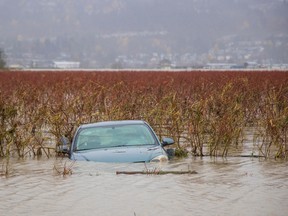Researchers say managed retreat is more cost effective and safer than rebuilding dikes and pump stations to prevent floods

Article content
Sumas Lake, which was drained in 1924 and converted into farmland in the Fraser Valley, should be restored to its natural state to prevent catastrophic flooding, says a new study from the University of B.C.
The study, published Monday in Frontiers in Conservation Science, is a collaboration between UBC scientists and members of the Sumas First Nation to look at ways to deal with severe flooding on the Sumas Prairie, which is expected to become worse because of climate change.
Advertisement 2
Article content
It’s a controversial idea because it would require the movement of multi-generational families, who have farmed the fertile Sumas Prairie since the 1920s. However, for the Semá:th, or Sumas, First Nation, the draining of the lake was a harmful decision as it destroyed their way of life — fishing, hunting for waterfowl and collecting plants for medicine around the lake.
UBC researchers did an economic analysis of “managed retreat,” which they describe as the purposeful relocation of people and infrastructure to safer areas. Using assessment data, they estimated buying out properties on the lake bed would cost around $1 billion, less than half the estimated $2.4 billion to repair dikes and install a new pump station.
Tara Martin, the study’s senior author and a professor of forest and conservation sciences at UBC, said B.C. needs to explore innovative solutions, not just build more expensive dikes.
“What we found really interesting is that in all of the proposals, managed retreat has not been on the table, it has not been discussed. They just keep looking at the same old things — building dikes, building pump stations, trying to keep the water away,” said Martin.
Article content
Advertisement 3
Article content
“But this is a time when we need to pivot. We know when we’re in a climate crisis. We know that we can’t keep doing the same things that we’ve done in the past.”
Working with co-author Murray Ned, a member of the Semá:th First Nation and executive director of the Lower Fraser Fisheries Alliance, UBC researchers learned that before the lake was drained, it supported five species of salmon, two species of sturgeon, and habitat to more than 50 species of birds.
“The recovery of that lake for salmon alone would be the largest restoration project for salmon in the entire province,” said Martin.
She said restoring the lake would provide a place for floodwaters to go, address past harms caused by the loss of the lake for the Semá:th people, and potentially provide farmers with a safer place to operate that is more insurable.
The UBC study does not provide recommendations of possible locations to move landowners, but Martin said they would like to open up a dialogue with farmers in the area to see whether it’s something they would consider.
“This was an initial first step, just to get this conversation on the table,” said Martin of the two-year study. “We felt that it was pertinent to get this initial analysis out there. But we would really like to better understand the cost of lost agriculture.”
Advertisement 4
Article content
Researchers note in the study that dike rehabilitation programs assume future water flows will be predictable; however, climate projections show that flooding events are likely to increase in the future.
“By restoring Sumas Lake — Semá:th Xhotsa — we can help the region adapt to future floods, facilitating climate resiliency in the long term. It is the most ecologically responsible solution for flood management in the region,” study author Riley Finn, a researcher at the Martin Conservation Decisions Lab at UBC, said in a statement.
Chief Dalton Silver of the Semá:th First Nation said the lake represented life and livelihood for his people.
“In 1924, the lake was drained in an instance of land theft, decimating an ecology that supported a rich and diverse Indigenous food system and replacing it with a settler food system,” he said in a statement issued by UBC.
“My grandpa used to say that in the Coast Salish Territory, Semá:th was the central location where the people used to gather. The people gathered in the summertime, as we had Semá:th Lake that once offered every species of fish right there at the front of our village. And in the wintertime, people gathered there from all parts of the Coast Salish Territory for the winter ceremonies.”
Advertisement 5
Article content
Ned said the research demonstrates that there are more economical and logical options that would allow First Nations to reconcile some of the past harms of draining the lake and ensure the farming community thrives in the region.
Asked whether managed retreat could work for Sumas Prairie, Abbotsford Mayor Ross Siemens said it would be a major undertaking that would involve all levels of government, and so for now Abbotsford’s focus remains on flood protection measures.
He said Abbotsford has the most productive agricultural land in Canada, and roughly 50 per cent of the dairy, poultry and eggs consumed in B.C. come from the region. It’s also a major supplier of various berries.
“A large majority of food production takes place in Sumas Prairie. Re-flooding Sumas Lake would mean losing that premium agriculture land and would significantly impact our provincial food supply,” said Siemens.
He said the farm economy is responsible for $3.83 billion in economic activity each year and supports 16,770 local jobs.
“As a municipality, our responsibility is to ensure that our community infrastructure protects our community and residents … which is why we are looking at flood protection measures versus re-flooding options,” he said.
Advertisement 6
Article content
Recommended from Editorial
Bookmark our website and support our journalism: Don’t miss the news you need to know — add VancouverSun.com and TheProvince.com to your bookmarks and sign up for our newsletters here.
You can also support our journalism by becoming a digital subscriber: For just $14 a month, you can get unlimited access to The Vancouver Sun, The Province, National Post and 13 other Canadian news sites. Support us by subscribing today: The Vancouver Sun | The Province.
Article content






